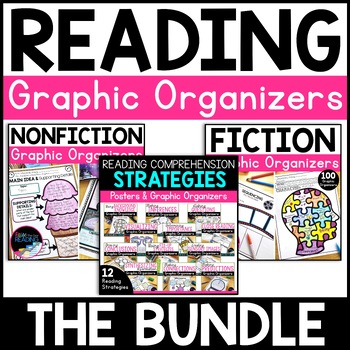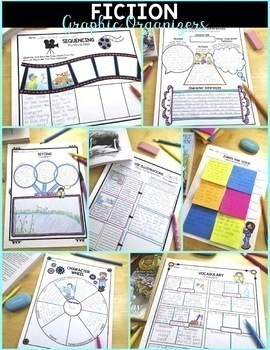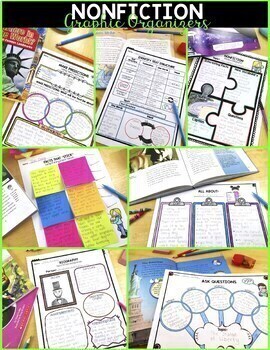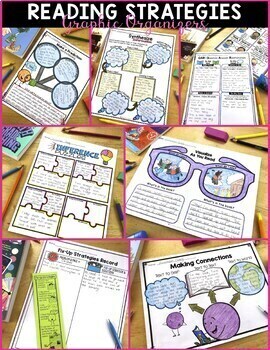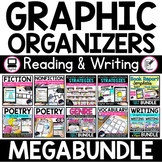Reading Comprehension Graphic Organizers: Fiction, Nonfiction, Strategy Response
- Zip
What educators are saying
Products in this Bundle (3)
Also included in
- Graphic organizers are an essential tool for differentiating and supporting all students in your classroom. This resource is packed full of a wide variety graphic organizers to practice skills and strategies needed in reading fiction, nonfiction, and using reading comprehension strategies! These orgPrice $27.80Original Price $94.50Save $66.70
- This Reading and Writing Graphic Organizers Megabundle includes ALL current graphic organizers, as well as any future graphic organizer packs added to my shop.Graphic organizers are an essential tool for differentiating and supporting all students in your classroom. This resource is packed full of aPrice $76.00Original Price $177.25Save $101.25
Description
Graphic organizers are an essential tool for differentiating and supporting all students in your classroom. This resource is packed full of a wide variety of printable graphic organizers to practice skills and strategies needed in reading fiction, nonfiction, and using reading comprehension strategies! These organizers have been thoughtfully aligned to the ELA Common Core for Grades 2-6.
WHAT'S INCLUDED:
1. Reading Comprehension Strategies Posters, Graphic Organizers & Activity Ideas
12 Reading Comprehension Strategies Posters: Each have images depicting how to use each strategy (Color or B&W). These reading comprehension strategies are research-based from the Keys to Comprehension by Susan Zimmerman.
1. Visualize/Create Mental Images
2. Make Connections
3. Ask Questions (includes separate QAR Poster)
4. Make Inferences
5. Determine Importance
6. Synthesize Information
7. Monitor Comprehension/Use "Fix Up" Strategies
8. Create Sensory Images
9. Make Predictions
10. Draw Conclusions
11. Use Background Knowledge/Use Schema
12. Close Read
5-15 Graphic Organizers per Reading Strategy: *Over 100 total* These graphic organizers can be used to fit a wide level of reading and writing abilities, making them perfect for differentiating reading strategy instruction in your classroom. All graphic organizers can be used for both fiction or nonfiction texts unless specified.
Follow-up Activity Ideas: Suggestions for classroom activities that provide students with additional practice using each Reading Comprehension Strategy
*100 Reading Fiction Graphic Organizers Total*
• Story Maps
• Plot Diagrams
• Setting
• Character Traits
• Analyzing Character
• Character Relationships
• Conflict/ Problem & Solution
• Sequencing
• Theme
• Cause & Effect
• Compare & Contrast
• Summarizing
• Using Text Evidence
• Using Illustrations
• Dialogue
• Using Reading Strategies
• Vocabulary
• Using Context Clues
• Point of View
• Book Response
• Ending Extension
• Protagonist vs Antagonist (Added 2/8/2021)
• Round vs Flat Characters (Added 2/8/2021)
• Retelling (Added 2/8/2021)
• Character Perspective (Added 2/8/2021)
• Types of Conflict (Added 2/8/2021)
• Reading Strategies (Added 2/8/2021)
• Making Predictions (Added 2/8/2021)
• Visualizing (Added 2/8/2021)
• Asking Questions (Added 2/8/2021)
3. Nonfiction Graphic Organizers
*125 Reading Nonfiction Graphic Organizers Total*
Topics: (More detail included in Table of Contents in the product preview):
• Facts & Key Details
• Determining Importance
• Compare & Contrast
• Main Idea & Details
• Multiple Main Ideas
• Summarizing Nonfiction
• Quoting & Paraphrasing
• Nonfiction Reading Response
• Using Nonfiction Text Features
• Identifying Nonfiction Text Structure
• Cause & Effect
• Sequencing
• Author’s Point of View
• Author’s Argument
• Using Quotes
• Finding Text Evidence
• Citing Text Evidence
• Vocabulary
• Using Context Clues
• Background Knowledge/KWL
• Making Inferences
• Asking Questions
• “How to” Response
• Biography Response
• Comparing Multiple Accounts
• Firsthand vs. Secondhand Accounts
• Claims & Evidence (Added 10/1/2021)
• Gathering Evidence from Multiple Sources (Added 10/1/2021)
• Nonfiction Book Report (Added 10/1/2021)
• Hamburger Paragraph Model (Added 10/1/2021)
• RACE Organizer (Added 10/1/2021)
British/Australian spelling also available upon request by e-mail to contactraisethebarreading@gmail.com. Just e-mail me with your order number and I will send them along!
© 2017 Raise the Bar Reading. Updated 2021.
Looking for more reading resources?
• Writing Units: Opinion, Informational & Narrative Writing for Grades 1-2

